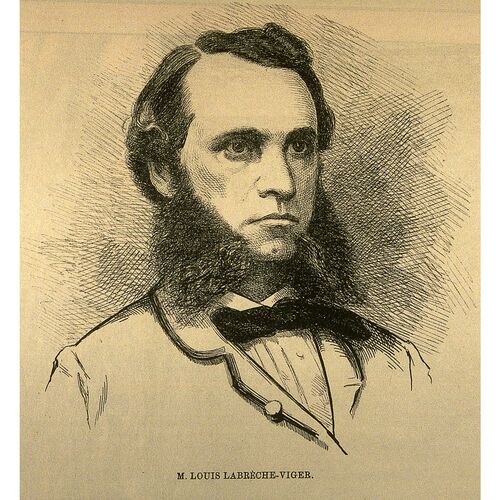LABRÈCHE-VIGER, LOUIS, journalist and politician; b. 1824 at Terrebonne, L.C., son of Louis Labrèche and Marguerite-Julie Viger; d. 27 April 1872 at Montreal, Que.
Born of parents who were farmers, Louis Labrèche was educated at the college of Montreal, probably thanks to the patronage of Denis-Benjamin Viger*, who persuaded the youthful student to contribute to L’Aurore des Canadas for some months. Out of either gratitude or admiration, Louis seems from then on to have added his protector’s name to his own. He spent two years at the seminary of Montreal, left it to study law in the office of Côme-Séraphin Cherrier*, another of Denis-Benjamin Viger’s protégés, and was called to the bar at Montreal on 27 April 1848.
It was as a member of the group of young men belonging to the Institut Canadien that Labrèche-Viger began to make himself known. In 1848, when this group started the Association pour le Peuplement des Cantons de l’Est, he acted with Joseph Doutre* as one of its two secretaries. Its aim was to check the movement of emigration to the United States that followed the insurrection, and to open for settlement the undeveloped areas of the Eastern Townships. Then Labrèche-Viger worked as a journalist with L’Avenir until 1851, and for some months in 1852 was editor of Le Pays. This means that at that time he was an annexationist, and one of the most enthusiastic supporters of the liberalism of the Institut Canadien. Later, in 1858, when the institute came into conflict with Bishop Ignace Bourget*, Louis Labrèche-Viger left it and drew up the declaration of the founders of the Institut Canadien-Français [see Cassidy].
Meanwhile, around 1852, he had become a merchant. An employee, then in 1854 a partner of the grocer Ephrem Hudon, he was also a member of the Trust and Loan Company. He entered the political arena again: in 1861 he was elected at Terrebonne by a majority of 30 votes over the outgoing member, Louis-Siméon Morin, and he was re-elected for the same county against the same opponent in 1863. He apparently made himself famous by never making a single speech in the house. However, he consistently voted on the side of the Rouge party. He also contributed to L’Ordre, and along with the editors of this paper he opposed confederation. At the time of the famous vote on 11 March 1865, he was one of the 21 French Canadian assemblymen who voted against the plan.
After 1867 Labrèche-Viger left politics in order to give his attention more and more to metallurgy, and to exploiting iron mines in the Rivière Moisie region [see Molson]. He incorporated a mining company, and became passionately absorbed in a search for the secret of the conversion of iron into steel. After three years of trials and tests, he thought he had found it, and obtained patents in Canada, the United States, and Great Britain. He also wanted to exploit the magnetic sands of the Rivière Moisie, and set up a laboratory on the banks of the Rivière Saint-Charles near Quebec. He died before learning the result of these experiments.
Louis Labrèche-Viger had married in 1852 a sister of Toussaint-Antoine-Rodolphe Laflamme*, Caroline, who bore him a son. According to contemporaries, he was a man of pleasing appearance, with an intelligent countenance and a shrewd mind. He was most affable in his demeanour and was always ready to be of service.
PAC, MG 30, D62 (Audet papers), 8, p.81. L’Avenir (Montréal), 1848–49. L’Opinion publique (Montréal), 16 mai 1872. Le Pays (Montréal), 1851. Cornell, Alignment of political groups. L.-O. David, Les gerbes canadiennes (Montréal, 1921), 43–50. Monet, Last cannon shot.
Cite This Article
Jacques Monet, “LABRÈCHE-VIGER, LOUIS,” in Dictionary of Canadian Biography, vol. 10, University of Toronto/Université Laval, 2003–, accessed January 10, 2026, https://www.biographi.ca/en/bio/labreche_viger_louis_10E.html.
The citation above shows the format for footnotes and endnotes according to the Chicago manual of style (16th edition). Information to be used in other citation formats:
| Permalink: | https://www.biographi.ca/en/bio/labreche_viger_louis_10E.html |
| Author of Article: | Jacques Monet |
| Title of Article: | LABRÈCHE-VIGER, LOUIS |
| Publication Name: | Dictionary of Canadian Biography, vol. 10 |
| Publisher: | University of Toronto/Université Laval |
| Year of publication: | 1972 |
| Year of revision: | 1972 |
| Access Date: | January 10, 2026 |


![M. Louis Labrèche-Viger [image fixe] Original title: M. Louis Labrèche-Viger [image fixe]](/bioimages/w600.4254.jpg)

